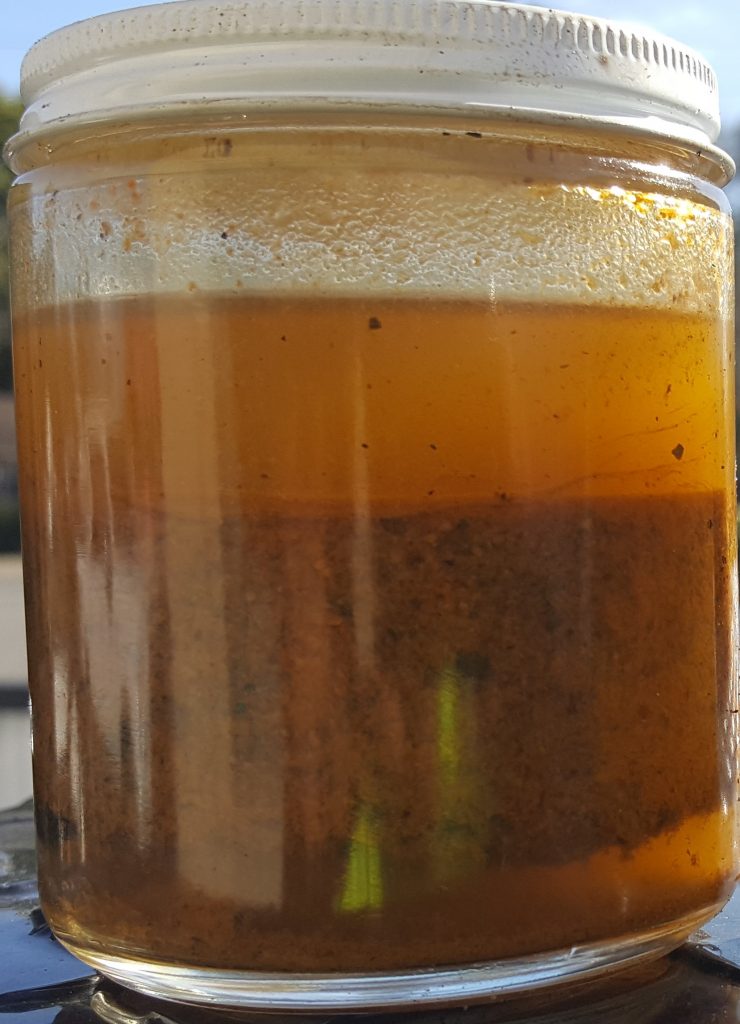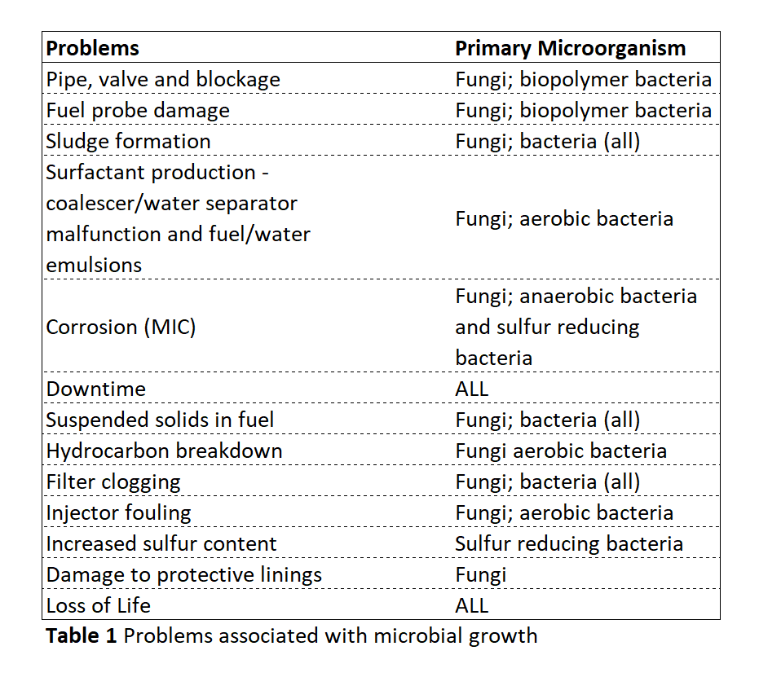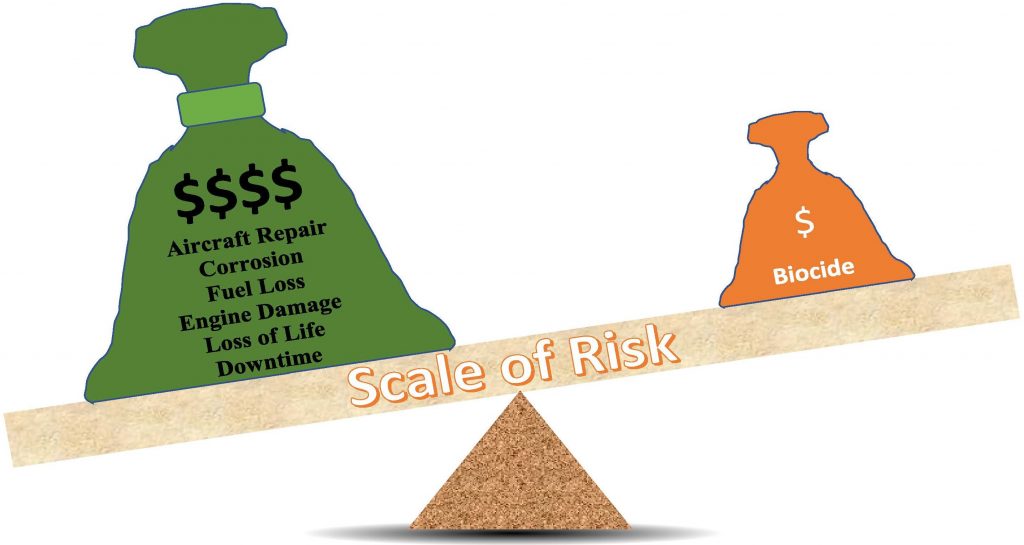AIRCRAFT APPLICATION OF FUEL BIOCIDE
Microbes are everywhere. They are in the air, ground, fuel and fuel systems. As such, the risk of biodeterioration is always present with the potential for increase, absent a fuel biocide. Rob Midgley, Global Technical and Quality Manger for Shell Aviation, recently pointed out that “somewhere around 50% or more of those aircraft” parked are showing “signs of microbial growth after two to three months of storage.” He goes on to say that “you really need to have a strategy to treat the aircraft.” Since there is no such thing as a sterile fuel system, biodeterioration can occur in the best maintained systems. To recognize the solution, lets briefly evaluate the problems, identify the risks and offer a practical conclusion.
Evaluating the Problems
Microbiological contamination begins the moment fuel leaves the refinery and continues to accumulate through the supply chain to its final destination. Microbes need water and food to survive and multiply. The consensus is, keep fuel dry and you reduce the chance of biodeterioration. However, that is easier said than done. Water is always present in fuel at some level and it doesn’t take much to sustain life. Fuels systems are constantly breathing, bringing in more contaminants including additional microbes and water in the form of condensation. A single drop of water can sustain colonies of microbes. As condensation forms, free water accumulates exacerbating the problem of microbial contamination. Long-term storage magnifies all of the problems linked to biodeterioration.

Fuel is a food source. Microbes consume fuel, breaking down the hydrocarbons and producing corrosive acids. They also change the composition of the fuel as they metabolize it. Microbes multiply at high rates and typically live in consortia. Never found alone, different species establish symbiotic relationships beneficial to each other forming biomass environments at water-fuel interfaces (Figure 1) on tank walls and linings or most any place in a fuel system capable of concealing a tiny fraction of water.
Ready sources of fuel and water are not the only problems. Aircraft fuel systems are designed for everything except easy microbiological control. While many designs incorporate water-scavenging systems and other devices to limit water, the complicated tank designs including baffles and individual tanks with transfer systems create a host of complications. Aircraft have limited access points making it difficult or near impossible to retrieve acceptable samples for testing or to inspect the system for the presence of biodeterioration. While draining sumps does help, the automated scavenging systems that are in use during operation are of no help while aircraft are parked. Water and bioburdens can easily accumulate in places hard to reach or detect and often go unrealized until contamination reaches very high, dangerous levels.
Fuel system design and the nature of the fuel testing process attribute to inconclusive results. Sample testing is diagnostic, not representative. A reliable sample should come from a location in the tank likely to harbor microbes such as a sump drain. That being said, testing can still be inconclusive. A negative test result does not indicate the fuel is free of microbial contaminants. In contrast, a positive result makes it that much more important to act, no matter how low the level of microbial contamination. If the test indicates a positive result, the likelihood of biodeterioration is dramatically increased.
Identifying the Risks
What are the risks associated with microbial contamination and more specifically with not using a fuel biocide? Table 1 represents the main risks linked by microorganism type. It is not difficult to see how potential problems can become both catastrophic and costly to remediate if not managed in a fundamental way. The facts are straightforward:
- Microbes are EVERYWHERE
- Water is ALWAYS present
- Microbes need WATER and FOOD
- Fuel is FOOD
- Fuel systems are NEVER sterile
- Good housekeeping ALONE is not enough
- Biocides KILL microbes
- The systematic use of BIOCIDES WORK

The risks are straightforward as well. From a risk approach, any of the problems in Table 1 will certainly increase operational costs as well as the potential for catastrophic event. They are all a cause for concern and action.
Practical Conclusion
Compare the cost to treat the fuel with a biocide and the cost to remediate repairs associated with the problems in Table 1. The cost differential and the risk associated with not using a biocide are staggering. The Scale of Risk illustrates this fact. A biocide treatment costs in the $100s versus repairs ranging in the $100,000s. The risks associated with not using a biocide are much higher than its use. The present unprecedented long-term storage of aircraft is proving to be more than a challenge. Inactivity raises the risk of serious contamination issues, often hidden from plain sight. A proactive, preventative approach reduces the risks associated with long-term storage. Early intervention is the key. If a diagnostic test indicates any level of microbial presence, a biocide treatment is the only way to ensure the risks are reduced.
Biobor products are the worldwide standard. Biobor®JF is the original, industry standard biocide since 1965, used in the most critical application – aviation. Independently tested, EPA registered and OEM approved for use in all hydrocarbons. It does not affect fuel performance and is more stable, less corrosive and safer to handle than other products. The Biobor family of products includes aviation, diesel fuel and gasoline additives designed to remediate, stabilize, clean and enhance fuel. If you manage fuel and fuel systems, and are not using additives as a way to reduce costs and liabilities contact the Biobor experts and find out how they can help you develop a personalize FQM program. If you are using non-Biobor products, contact us and find out why you need to make the change to Biobor.
Follow BioborShare the Post









